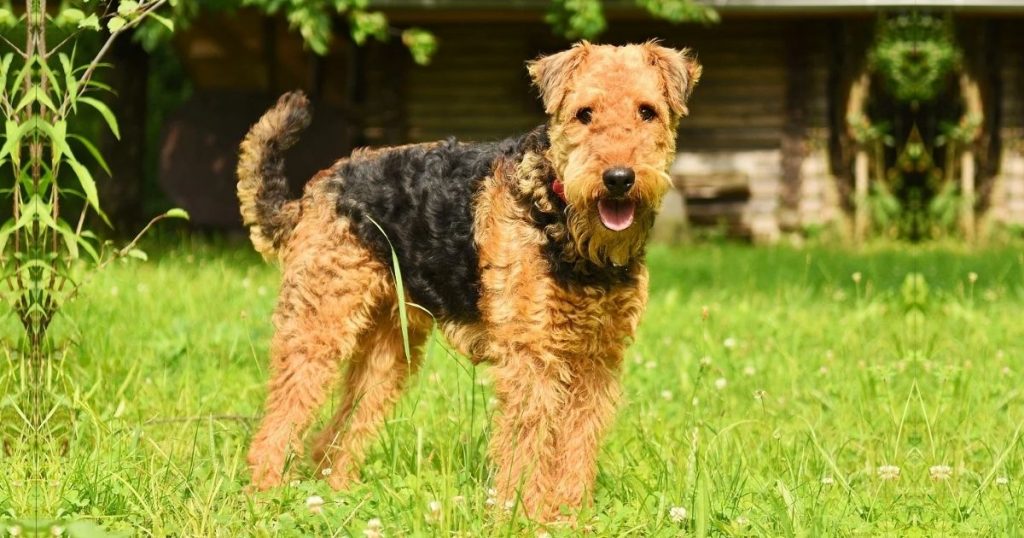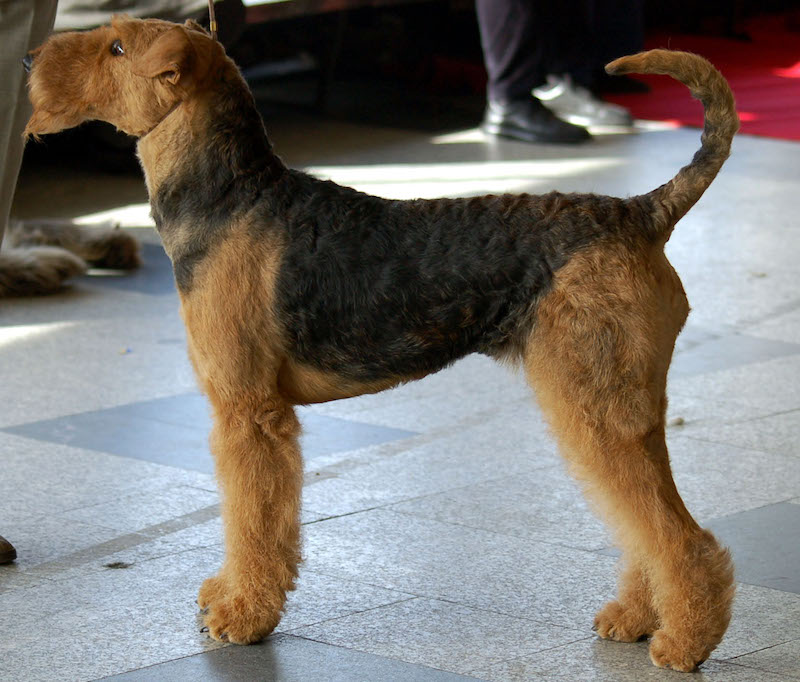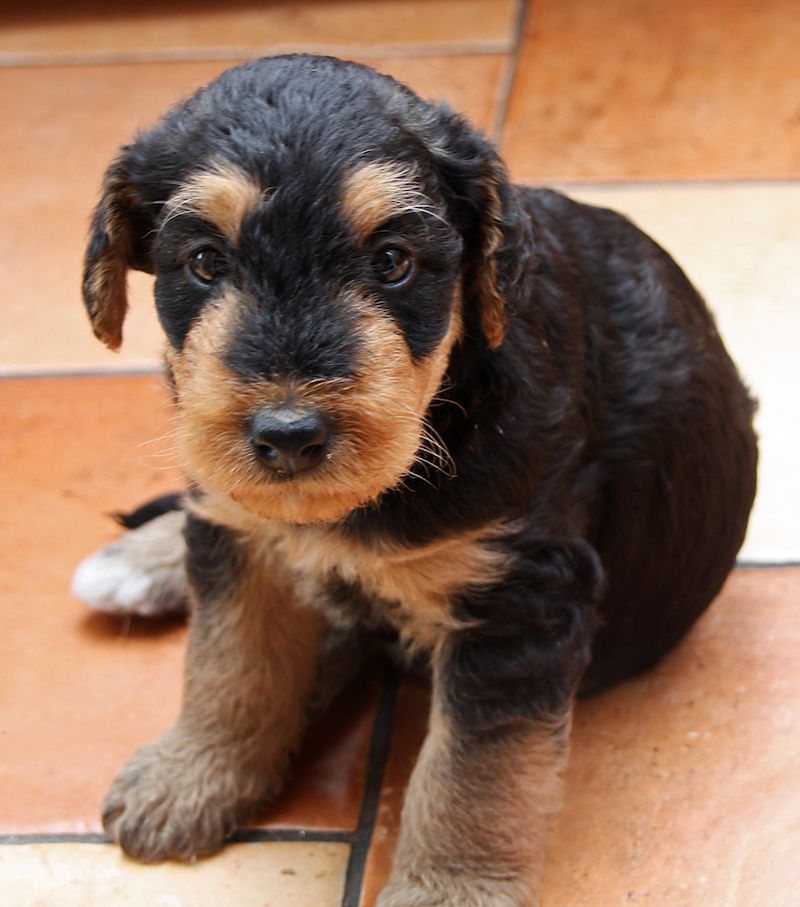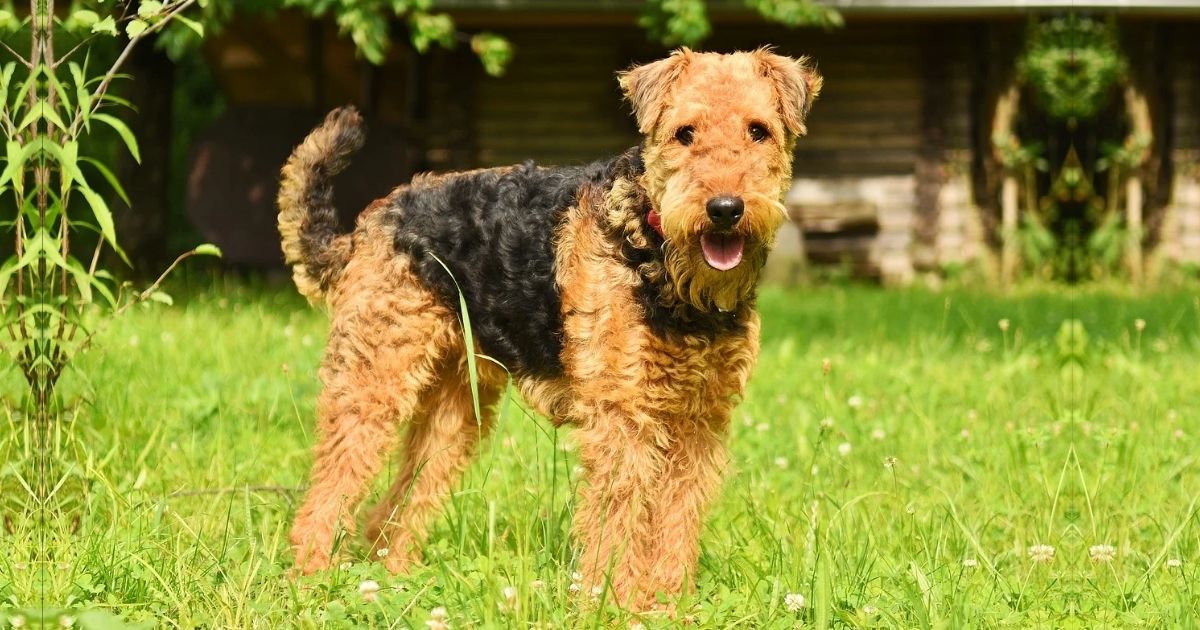Heralded as the ‘King of Terrier’, Airedale is a fighter, hunter, and worker. Their versatility and strength make them good for active services and fit to be family companions.
You may be reading this because you want a pet, and we know that is not a light decision.
Things to consider are so numerous, it feels easier to throw in the towel.
You need a dog that can fit into your living environment, family, lifestyle, and level of activity.
However, adequate information makes your pet search easier. When you’re loaded with knowledge of different dog breeds, you can easily decide what you want.
Perhaps you’re not looking for a pet but you’re someone interested in learning more about different breeds. This is also a good space for you.
Here are all about the Airedale Terrier facts and dog breed information to satisfy your thirst for knowledge and decide if the Airedale is right for you.
Airedale Terrier facts and dog breed information

| Dog Breed Group | Terrier Dogs |
| Height | 21 to 23 inches |
| Weight | 40 to 65 pounds |
| Coat | Hard and wiry |
| Color(s) | Black, white, gray |
| Life Expectancy | 10–13 years |
| Temperament | Intelligent, stubborn, playful, independent |
| Origin | England |
| Bred For | Hunting and working |
| Nickname(s) /Other Name(s) | King of Terrier, Waterside Terrier, Bingley Terrier |
| Recognized by the AKC | Yes |
| Recognized by the UKC | Yes |
Airedale Terrier Characteristics
| Characteristics | Rating |
|---|---|
| Adaptability | 2/5 |
| Friendliness | 4/5 |
| Child Friendly | 4/5 |
| Pet Friendly | 4/5 |
| General Health | 3/5 |
| Grooming Needs | 4/5 |
| Trainability | 3/5 |
| Intelligence | 4/5 |
| Playfulness | 4/5 |
| Exercise Needs | 4/5 |
| Energy Level | 4/5 |
| Tendency to Bark | 4/5 |
| Tendency to Drool | 2/5 |
| Tendency to Snore | 1/5 |
| Tendency to Dig | 4/5 |
Little known facts about Airedale Terrier dog breed

Fact #1: Airedale is the largest Terrier dog
Airedales were nicknamed the ‘King of Terriers’ because of their size. With a height of 23 inches at shoulder level, they are the largest terriers in the world today.
Of course, this size doesn’t preclude them from the different works they do. If anything, it gives them an advantage.
Fact #2: They served in World War I
Airedales have always been versatile due to their intelligence and hardworking nature.
What many may not know, however, is that they participated as an active force in the First World War.
They were under the British Army and were instrumental to battle victories.
Airedales risked their lives during the war to deliver messages and warn troops of approaching enemies.
Fact #3: They were ratters
Though they now have many other purposes, Airedales started out as ratters.
They hunted large rats and rodents for the benefit of their owners.
Their hunting skills also came in handy in competitions. They were contestants in a lot of rat hunting contests.
Fact #4: An Airedale got a posthumous award
During the First World War, an Airedale was charged with an important assignment.
The lives of his battalion were in his hands, and he did not take that lightly. The battalion needed reinforcement after getting isolated by enemy forces.
Jack, the Airedale, put his life at risk and went through enemy lines to deliver the message.
While he achieved his aim in the end, he got injured in the process and died. He was awarded the Victoria Cross for “gallantry in the field.”
Fact #5: They were part of the first police dogs in some countries
In countries like Great Britain and Germany, Airedales were a favorite choice of dogs for the police, before the German Shepherd even.
They became some of the first dogs to work with the cops. They were good candidates due to their intelligence, strength, and bravery.
Breed History & Origin
In 1853, a Black and Tan Terrier was crossed with an Otterhound.
The aim of this cross-breeding was to develop a sport dog who’d be good at sporting events and hunt both otters and rats.
The result of that experiment was a terrier named the Bingley Terrier or Waterside Terrier.
This new breed had the ability to swim, hunt, work, and play. The experiment was a success, to say the least.
In 1864, this new breed competed in a dog show at Airedale valley. After judge Hugh Dalziel gave a positive review, more people got interested in the breed.
Controversies over its name and birthplace also sprouted. Then, a group of fanciers came together and renamed the Bingley/Waterside Terrier the Airedale Terrier.
22 years later, the English Kennel Club recognized ‘Airedale Terrier’ as the official name.
The first Airedale to enter the United States was named Bruce in 1881. In 1888, the American Kennel Club recognized the breed.
In 1990, the Airedale Terrier Club of America was formed.
Airedales played a major role in the first world war under the British Army. They worked as couriers to deliver messages through battlefields.
The Red Cross employed them as well to locate injured soldiers.
Many Airedales were notable in the war including Jack, the dog who risked his life to deliver an SOS message that saved his battalion.
They have since integrated into family life while maintaining their numerous skills.
Airedale Terrier Temperament & Intelligence
Airedales are hardworking, courageous, strong dogs who can compete in sports, be watchdogs and companions.
They are also playful with a good sense of humor and enough affection to go around.
Don’t be surprised if your Airedale plays some mischievous pranks on you or any member of your family.
They don’t mature fast, so expect puppyish behaviors for a long time.
They love having work to do. As hard workers, they don’t do well with idleness.
Ensure you keep them busy so they won’t get bored and engage in destructive activities.
They are playful with kids and get along well with them, though you should supervise any interaction your kid has with a canine. Plus, their size may not be good for small children.
Airedales are independent thinkers with a keen sense of smell, a gift from their hound ancestor.
They are used to doing things their own way and may not wait for your command before acting. This is laudable but can become tricky when you want to train them.
New dog owners are not advised to get an Airedale as they are stubborn, dominant, and need a confident leader to make them know their place.
With enough positive reinforcements, rewards, socialization, and activities, Airedales thrive.
If you can take up the challenge of training a dog who isn’t a ‘yes sir’ kind of breed, have a shot at them.
While they are watchdogs and defend their families when need be, they are friendly with visitors. With other pets, however, it is not certain.
Their hunting instinct makes them unfit to stay in a house with a smaller pet, especially a rodent.
Like other terriers, Airedales tend to dig, chase after other animals, and bark. Take note of that to avoid frustrations.
Is an Airedale Terrier a good family dog?
Airedales are hardworking, courageous, strong dogs who are good watchdogs and companions.
They are also playful, humourous, affectionate, friendly towards visitors, and loving.
They are sacrificial and would defend your family with all they have. These traits make them good family dogs.
This doesn’t mean they are for everyone. Dogs like Airedales are not a ‘one size fits all.’
They have requirements and, if you can’t meet that, they may not be good for you.
Are Airedale Terriers good with kids?
Airedales are kid-friendly dogs and will not react in a way that would put your child at risk. Their playfulness, affection, and protectiveness make them good babysitters for your little ones.
Of course, one can not be too comfortable leaving a dog with a child unsupervised. Ensure you are present when your child plays with a dog and keep watch.
You also have to consider their size before letting your kid close to them. While they won’t hurt a child on purpose by biting or scratching, they may knock that child down while playing.
It’s best to wait till your kids get to a certain age before letting them be with an Airedale.
Are Airedales good with other dogs and pets?
With proper training, Airedales can live comfortably with other dogs in your household.
They won’t extend that courtesy to stranger dogs, however. If they see the dog as an enemy getting into their territory, they will get aggressive.
There’s also a prey drive to consider. Airedales will see any small animal as prey, especially rodents.
Thus, it may not be a good idea to have a mouse or hamster when you already have an Airedale.
Male vs Female Airedale Terrier
The male and female of any breed come with a set of strengths and weaknesses.
For most owners, gender is a matter of preference. If you want to get your dog neutered,
then gender should not be an issue for you. However, if you prefer an unneutered pet, you may want to get information on the gender differences to make your choice easier.
The weight and height of a male and female Airedale count as the first difference.
The male Airedale weighs up to 50 pounds with a height of 24 inches.
In contrast, the female Airedale weighs around 40 pounds with a height of 23 inches.
Another difference is in the genitals. In general, the male genitals of any dog breed are visible and stick out, unlike the female.
Caring for an Airedale Terrier
The Airedale is an outdoor pet that finds it hard to adapt to apartment living.
They are not advisable for those living in flats or small houses, but okay if you have a yard or live in the countryside.
They are energetic and do well with space. It is best to keep them in an open area where they can freely use up their energy.
They also require exercise or they may seek other less constructive ways to be busy.
Airedales are trainable if you’re ready for a challenge. While they do co-operate, their independent spirit makes them think on their own. Be ready for some stubbornness.
They have a moderate grooming need and stay healthy with good food and regular checkups.
Airedale Terrier Food and Diet
What you feed your dog helps with his growth, overall health, and fitness. A poor meal puts dogs at risk.
You have to get the right diet and proportion to avoid them either being underweight or overweight as both situations come with consequences.
Airedales require a diet filled with beneficial nutrients. You can’t afford to be negligent and scoop any food into his bowl.
Their large terrier size and high energy should be put into account when giving them their meals for the day.
Proper feeding for the Airedale is quality dry food in about 1½ and 2½ cups, split into two meals. Overfeeding Airedales can make them pile on unhealthy pounds, a situation you should rather avoid.
Obese Airedales are prone to breathing, digestive, and muscle complications. If your dog is overweight, he needs less food and more exercise.
Certain nutrients are good for your Airedale and should not be found missing in their meals. These nutrients come highly recommended. Some of them are:
- Protein
- Fats
- Water
- Minerals
Meanwhile, avoid feeding them meals that contain:
- Wheat
- Rice
- Corn
- Garlic
- Chocolate
Puppies and adult dogs do not have the same meal requirements, just like humans adults don’t eat like babies. The way you’d feed a puppy should differ from an adult.
As a general rule, the Airedale puppy eats more than the adult. At 2 to 8 months, they need about 3 meals in a day.
As they grow, reduce it according to their needs and limitations.
The old Airdale requires lesser than both puppies and young adults. Their meal should be of a smaller quantity.
Airedale Terrier Exercise
Regular exercise is necessary for your dog, irrespective of personality, size, and appearance. As humans exercise to keep fit, dogs need to work out their bodies.
For some dogs, lack of exercise can get them antsy. Even if your dog isn’t energetic, exercise him.
Note that dogs have different exercise needs. Some dogs can go up to 30 minutes or an hour.
Others are content with simple movements after which they lie down for the rest of the day.
Before choosing a dog, you have to know whether you can cope with the exercise demands. Of course, this depends on your lifestyle, personality, and daily schedule.
Airedales are highly energetic and need to burn it out. They love being active and are not used to sitting idle. A high-level exercise of at least one hour is what satisfies them.
If you are not a sports enthusiast, consider another breed other than the Airdale.
The physical exercise consists of walks, jogs, frisbee toss, fetch, and swimming. In addition to physical activities, add some mental challenges to keep their busy mind working.
Puppies, in general, need a less strenuous exercise regime. Prevent them from engaging in activities like jumping and running until they are a bit older.
Simple exercises like a short distance walk are enough for an Airedale.
Older dogs don’t need as much exercise as younger ones, but you still have to keep them fit. This helps them in weight management and prevents joint pains.
Dogs are man’s best friend only when they are trained. When they lack training, they become dangerous to everyone.
Even a gentle breed can turn wild when neglected. Thus, before you get a dog, you need to answer these few questions:
- Do I have the time to commit to my dog’s upbringing?
- Am I experienced enough?
- Can the breed be a domestic pet?
- How trainable is my favorite dog breed?
Also, know how to distinguish training from abuse. While you need confidence and strictness to teach your dog good manners, harsh treatments and punishments are not necessary and will do more harm than good.
Socialization is mandatory for dogs. Take them to different places and unwrap the world. Let them meet new people, get accustomed to unfamiliar sights, smell unknown scents and be friendly.
The Airedale’s independent spirit makes him resist instructions. You need to be an alpha leader with firmness and confidence.
Also, use positive methods—like praises—to gain fruitful results. Diversify their training sessions because they get bored quickly.
Start them off as puppies with simple commands like:
- Sit
- Heel
- Stay
- Down
Of course, knowing these commands is not enough. You must be consistent in making sure your Airedale complies. They can be stubborn.
Airedale Terrier Grooming Needs
Alongside other needs, your dog should be neat and presentable. It doesn’t appear good if your dog turns up looking shabby, unruly, and dirty.
Some dogs shed a lot, others don’t. Either way, they should be groomed.
If you have the experience and time, you may do it yourself. If not, consider hiring a groomer to get the job done.
Airedales shed at a moderate level during certain periods of the year. They don’t need to always be trimmed, but some owners do hire professional groomers to do so. Note that trimming an Airedale isn’t easy and a pro groomer would be costly.
Their teeth and nails shouldn’t be neglected too. Brush those teeth at least twice a week and trim their nails like once or two times per month before they get too long.
As you clean up them, check out for signs of infection, illness, or injury. If you come across any, get your dog to the vet. Common signs include:
- Sores
- Inflammation
- Red eyes
- Rashes
Also, check your Airedale’s ears on a regular basis and clean them with a cotton ball plus a recommended cleanser.
Do not stick any random object into their ears. If there are red spots in the ear or an odor, you may be dealing with an ear infection.
Start grooming an Airedale when they are still pups. The same goes for other dogs to get them used to being touched. This would also make a veterinarian’s work easier.
Airedale Terrier Health Conditions
Unfortunately, we fall sick. As much as we put effort to prevent certain health conditions, we cannot totally avoid them. The case is similar for dogs, cats, and other animals.
When you get a pet, it is important you ensure the health factor is in place and keep in mind possible medical conditions.
Airedales have a relatively long life span when all needs are met. However, there may suffer from minor and major illnesses like:
Hip dysplasia
Hip dysplasia is an inherited medical issue that affects the hips, causes pains, and can lead to lameness.
When getting an Airedale, be sure your breed did not inherit this defect.
Allergies
Like many dogs, Airedales are allergic to some substances. Signs of an allergy include rubbing paws and frequent ear infections.
Your pet can be allergic to a meal, chemicals, and natural elements like pollen. There are treatments for allergic reactions.
Cancer
Cancer is lethal in both humans and in dogs. Symptoms include sores, bleeding, swelling, or breathing difficulties. It can be treated surgically, with chemotherapy, or otherwise.
Bloating
Airedales are vulnerable to bloating. This occurs when their stomachs get filled up with nothing but gas.
This condition is a cause for concern as it is lethal, and may take a dog down under minutes. Rush your Airedale to a vet if you detect any belly swellings and discomfort.

Frequently Asked Questions
Is an Airedale Terrier right for you?
Airedales come with a lot of qualities that make them good family companions. They are strong, protective, affectionate, and kid-friendly. When well trained, they are a delight to have.
This doesn’t mean they are for everyone. Consider your lifestyle, pet preference, and environment before choosing this breed.
They are not too easy to train, much to the surprise of some owners who get deceived by their playfulness. They need an experienced, strong owner.
If you can cope with the challenge of owning and training an independent, ex-war dog, the Airedale is right for you. If not, go for another dog breed.
What are Airedale Terriers known for?
Airedales are popular for a myriad of reasons. They showed courage and sacrifice in the first world war. Some of them earned awards for their services.
They were also police dogs, ratters, hunters, and athletes. They are hard workers and versatile, two good reasons they are in families today.
How big is a full-grown Airedale Terrier?
A fully grown Airedale is the largest of all Terriers. That’s why he is the ‘King of all Terriers’. They weigh up to 65 pounds and get as tall as 23 inches.
Do Airedale Terriers like to cuddle?
Though they are playful and loving, Airedales are energetic and outdoorsy. They are less inclined to curl up on the couch with you, cuddling. You’d rather find them out in the yard.
Is it hard to take care of an Airedale Terrier?
Airedales don’t shed much, but they do get trimmed from time to time, an activity that is difficult. They also need at least 1 hour of exercise and firm training.
You have to be ready to commit to an Airedale because he is not easy to take care of.
How Long do Airedale Terriers live?
Airedales are healthy, strong animals with a long life span, all things being equal. Their duration falls between 10 and 13 years.
How much do Airedale Terriers cost?
Airedales are famous and sought after, which makes them costly. Your choice of pedigree determines how much you spend to get one.
Airedale Terriers’ puppy prices range from $800 to $1500. To adopt a grown dog costs around $300.
Do Airedale Terriers shed?
Airedales shed at a moderate level and only during some periods of the year. They require extra attention when their shedding season comes on.
Final Thoughts
With an Airedale, expect a full package. They have their pros and cons, so they are not suitable for everyone. You should do your homework before getting one.
The information in this Airedale Terrier facts and dog breed information is a good starting point. It shouldn’t be difficult to decide whether or not the Airedale Terrier is the right dog for you.
Consider adoption if you want one.
Like any other breed and animal, they deserve your love and commitment to training them into dogs that fit into society. You equally should meet their needs for exercise, space, and activities.
Related: Complete Alphabetical List of Dog Breeds
Useful Resource
- Official Profiles:
- American Kennel Club (AKC): Airedale Dog Breed Information
- The Kennel Club (KC): Airedale Terrier
- Australian National Kennel Council: Aredale Terrier







